19英语阅读-经济学人《Economics》双语版-Fair enough
- 格式:docx
- 大小:22.87 KB
- 文档页数:7
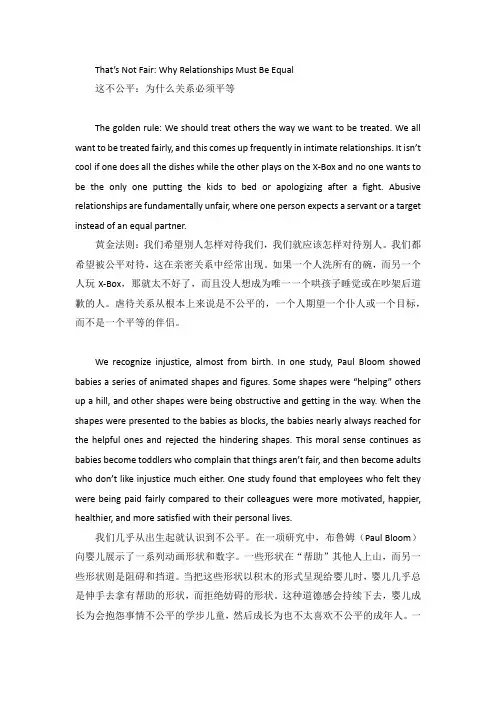
That’s Not Fair: Why Relationships Must Be Equal这不公平:为什么关系必须平等The golden rule: We should treat others the way we want to be treated. We all want to be treated fairly, and this comes up frequently in intimate relationships. It isn’t cool if one does all the dishes while the other plays on the X-Box and no one wants to be the only one putting the kids to bed or apologizing after a fight. Abusive relationships are fundamentally unfair, where one person expects a servant or a target instead of an equal partner.黄金法则:我们希望别人怎样对待我们,我们就应该怎样对待别人。
我们都希望被公平对待,这在亲密关系中经常出现。
如果一个人洗所有的碗,而另一个人玩X-Box,那就太不好了,而且没人想成为唯一一个哄孩子睡觉或在吵架后道歉的人。
虐待关系从根本上来说是不公平的,一个人期望一个仆人或一个目标,而不是一个平等的伴侣。
We recognize injustice, almost from birth. In one study, Paul Bloom showed babies a series of animated shapes and figures. Some shapes were “helping” others up a hill, and other shapes were being obstructive and getting in the way. When the shapes were presented to the babies as blocks, the babies nearly always reached for the helpful ones and rejected the hindering shapes. This moral sense continues as babies become toddlers who complain that things aren’t fair, and then become adults who don’t like injustice much either. One study found that employees who felt they were being paid fairly compared to their colleagues were more motivated, happier, healthier, and more satisfied with their personal lives.我们几乎从出生起就认识到不公平。
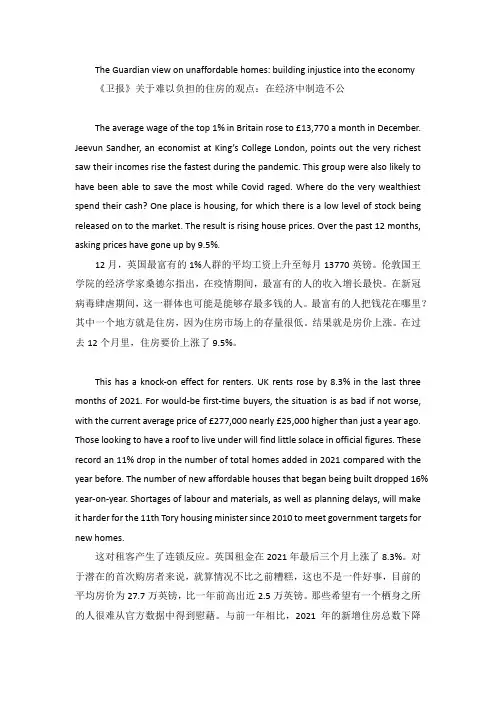
The Guardian view on unaffordable homes: building injustice into the economy《卫报》关于难以负担的住房的观点:在经济中制造不公The average wage of the top 1% in Britain rose to £13,770 a month in December. Jeevun Sandher, an economist at King’s College London, points out the very richest saw their incomes rise the fastest during the pandemic. This group were also likely to have been able to save the most while Covid raged. Where do the very wealthiest spend their cash? One place is housing, for which there is a low level of stock being released on to the market. The result is rising house prices. Over the past 12 months, asking prices have gone up by 9.5%.12月,英国最富有的1%人群的平均工资上升至每月13770英镑。
伦敦国王学院的经济学家桑德尔指出,在疫情期间,最富有的人的收入增长最快。
在新冠病毒肆虐期间,这一群体也可能是能够存最多钱的人。
最富有的人把钱花在哪里?其中一个地方就是住房,因为住房市场上的存量很低。
结果就是房价上涨。
在过去12个月里,住房要价上涨了9.5%。
This has a knock-on effect for renters. UK rents rose by 8.3% in the last three months of 2021. For would-be first-time buyers, the situation is as bad if not worse, with the current average price of £277,000 nearly £25,000 higher than just a year ago. Those looking to have a roof to live under will find little solace in official figures. These record an 11% drop in the number of total homes added in 2021 compared with the year before. The number of new affordable houses that began being built dropped 16% year-on-year. Shortages of labour and materials, as well as planning delays, will make it harder for the 11th Tory housing minister since 2010 to meet government targets for new homes.这对租客产生了连锁反应。
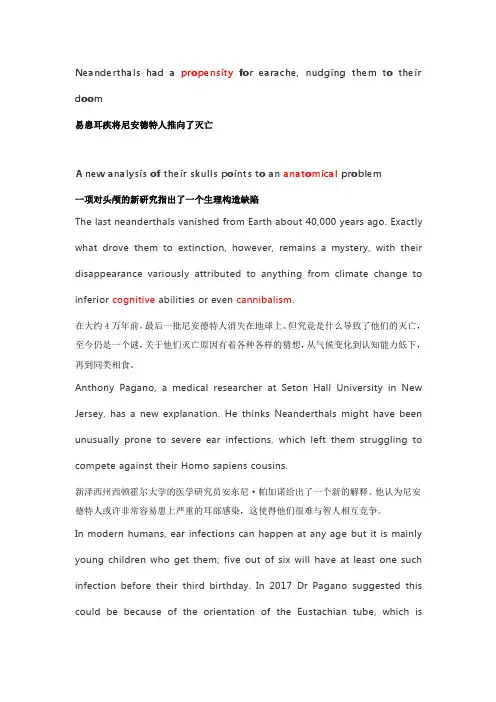
Neanderthals had a propensity for earache,nudging them to their doom易患耳疾将尼安德特人推向了灭亡A new analysis of their skulls points to an anatomical problem一项对头颅的新研究指出了一个生理构造缺陷The last neanderthals vanished from Earth about40,000years ago.Exactly what drove them to extinction,however,remains a mystery,with their disappearance variously attributed to anything from climate change to inferior cognitive abilities or even cannibalism.在大约4万年前,最后一批尼安德特人消失在地球上。
但究竟是什么导致了他们的灭亡,至今仍是一个谜,关于他们灭亡原因有着各种各样的猜想,从气候变化到认知能力低下,再到同类相食。
Anthony Pagano,a medical researcher at Seton Hall University in New Jersey,has a new explanation.He thinks Neanderthals might have been unusually prone to severe ear infections,which left them struggling to compete against their Homo sapiens cousins.新泽西州西顿霍尔大学的医学研究员安东尼·帕加诺给出了一个新的解释。
他认为尼安德特人或许非常容易患上严重的耳部感染,这使得他们很难与智人相互竞争。
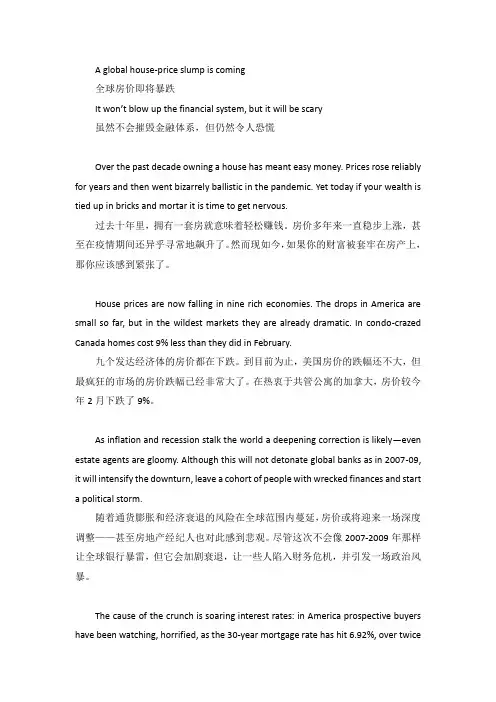
A global house-price slump is coming全球房价即将暴跌It won’t blow up the financial system, but it will be scary虽然不会摧毁金融体系,但仍然令人恐慌Over the past decade owning a house has meant easy money. Prices rose reliably for years and then went bizarrely ballistic in the pandemic. Yet today if your wealth is tied up in bricks and mortar it is time to get nervous.过去十年里,拥有一套房就意味着轻松赚钱。
房价多年来一直稳步上涨,甚至在疫情期间还异乎寻常地飙升了。
然而现如今,如果你的财富被套牢在房产上,那你应该感到紧张了。
House prices are now falling in nine rich economies. The drops in America are small so far, but in the wildest markets they are already dramatic. In condo-crazed Canada homes cost 9% less than they did in February.九个发达经济体的房价都在下跌。
到目前为止,美国房价的跌幅还不大,但最疯狂的市场的房价跌幅已经非常大了。
在热衷于共管公寓的加拿大,房价较今年2月下跌了9%。
As inflation and recession stalk the world a deepening correction is likely—even estate agents are gloomy. Although this will not detonate global banks as in 2007-09, it will intensify the downturn, leave a cohort of people with wrecked finances and start a political storm.随着通货膨胀和经济衰退的风险在全球范围内蔓延,房价或将迎来一场深度调整——甚至房地产经纪人也对此感到悲观。
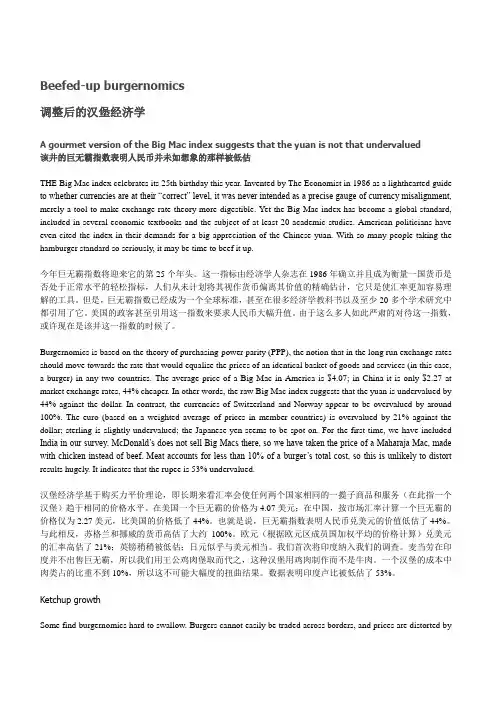
Beefed-up burgernomics调整后的汉堡经济学A gourmet version of the Big Mac index suggests that the yuan is not that undervalued该井的巨无霸指数表明人民币并未如想象的那样被低估THE Big Mac index celebrates its 25th birthday this year. Invented by The Economist in 1986 as a lighthearted guide to whether currencies are at their “correct” level, it was never intended as a precise gauge of currency misalignment, merely a tool to make exchange-rate theory more digestible. Yet the Big Mac index has become a global standard, included in several economic textbooks and the subject of at least 20 academic studies. American politicians have even cited the index in their demands for a big appreciation of the Chinese yuan. With so many people taking the hamburger standard so seriously, it may be time to beef it up.今年巨无霸指数将迎来它的第25个年头。
这一指标由经济学人杂志在1986年确立并且成为衡量一国货币是否处于正常水平的轻松指标,人们从未计划将其视作货币偏离其价值的精确估计,它只是使汇率更加容易理解的工具。
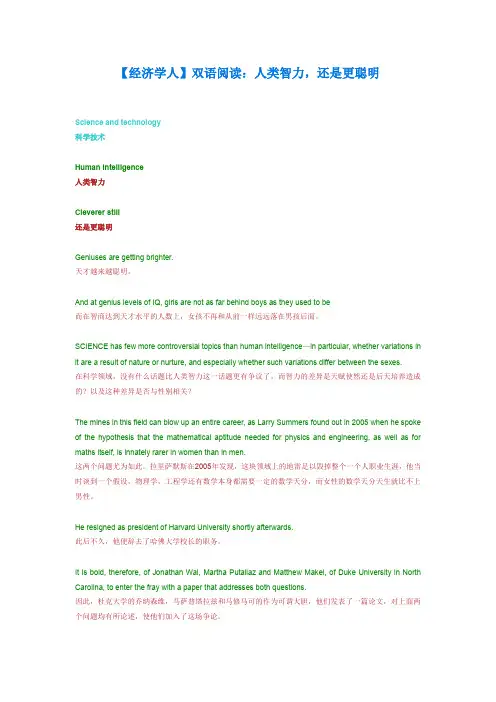
【经济学人】双语阅读:人类智力,还是更聪明Science and technology科学技术Human intelligence人类智力Cleverer still还是更聪明Geniuses are getting brighter.天才越来越聪明。
And at genius levels of IQ, girls are not as far behind boys as they used to be而在智商达到天才水平的人数上,女孩不再和从前一样远远落在男孩后面。
SCIENCE has few more controversial topics than human intelligence—in particular, whether variations in it are a result of nature or nurture, and especially whether such variations differ between the sexes.在科学领域,没有什么话题比人类智力这一话题更有争议了,而智力的差异是天赋使然还是后天培养造成的?以及这种差异是否与性别相关?The mines in this field can blow up an entire career, as Larry Summers found out in 2005 when he spoke of the hypothesis that the mathematical aptitude needed for physics and engineering, as well as for maths itself, is innately rarer in women than in men.这两个问题尤为如此。
拉里萨默斯在2005年发现,这块领域上的地雷足以毁掉整个一个人职业生涯,他当时谈到一个假设,物理学,工程学还有数学本身都需要一定的数学天分,而女性的数学天分天生就比不上男性。
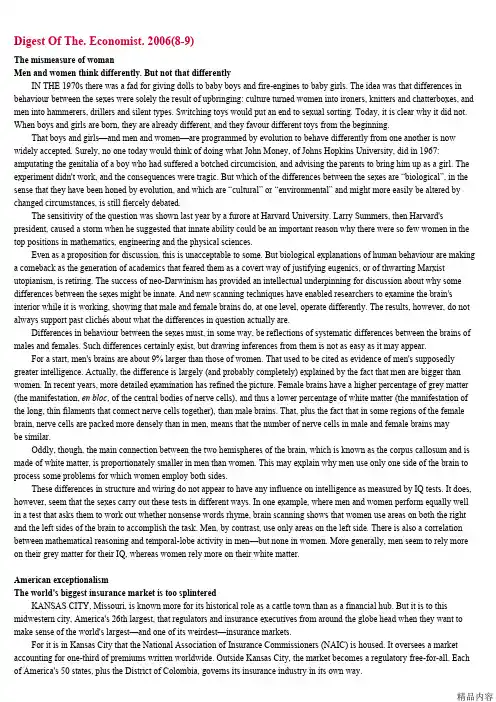
Digest Of The. Economist. 2006(8-9)The mismeasure of womanMen and women think differently. But not that differentlyIN THE 1970s there was a fad for giving dolls to baby boys and fire-engines to baby girls. The idea was that differences in behaviour between the sexes were solely the result of upbringing: culture turned women into ironers, knitters and chatterboxes, and men into hammerers, drillers and silent types. Switching toys would put an end to sexual sorting. Today, it is clear why it did not. When boys and girls are born, they are already different, and they favour different toys from the beginning.That boys and girls—and men and women—are programmed by evolution to behave differently from one another is now widely accepted. Surely, no one today would think of doing what John Money, of Johns Hopkins University, did in 1967: amputating the genitalia of a boy who had suffered a botched circumcision, and advising the parents to bring him up as a girl. The experiment didn't work, and the consequences were tragic. But which of the differences between the sexes are “biological”, in the sense that they have been honed by evolution, and which are “cultural” or “environmental” and might more easily be altered by changed circumstances, is still fiercely debated.The sensitivity of the question was shown last year by a furore at Harvard University. Larry Summers, then Harvard's president, caused a storm when he suggested that innate ability could be an important reason why there were so few women in the top positions in mathematics, engineering and the physical sciences.Even as a proposition for discussion, this is unacceptable to some. But biological explanations of human behaviour are making a comeback as the generation of academics that feared them as a covert way of justifying eugenics, or of thwarting Marxist utopianism, is retiring. The success of neo-Darwinism has provided an intellectual underpinning for discussion about why some differences between the sexes might be innate. And new scanning techniques have enabled researchers to examine the brain's interior while it is working, showing that male and female brains do, at one level, operate differently. The results, however, do not always support past clichés about what the differences in question actually are.Differences in behaviour between the sexes must, in some way, be reflections of systematic differences between the brains of males and females. Such differences certainly exist, but drawing inferences from them is not as easy as it may appear.For a start, men's brains are about 9% larger than those of women. That used to be cited as evidence of men's supposedly greater intelligence. Actually, the difference is largely (and probably completely) explained by the fact that men are bigger than women. In recent years, more detailed examination has refined the picture. Female brains have a higher percentage of grey matter (the manifestation, en bloc, of the central bodies of nerve cells), and thus a lower percentage of white matter (the manifestation of the long, thin filaments that connect nerve cells together), than male brains. That, plus the fact that in some regions of the female brain, nerve cells are packed more densely than in men, means that the number of nerve cells in male and female brains maybe similar.Oddly, though, the main connection between the two hemispheres of the brain, which is known as the corpus callosum and is made of white matter, is proportionately smaller in men than women. This may explain why men use only one side of the brain to process some problems for which women employ both sides.These differences in structure and wiring do not appear to have any influence on intelligence as measured by IQ tests. It does, however, seem that the sexes carry out these tests in different ways. In one example, where men and women perform equally well in a test that asks them to work out whether nonsense words rhyme, brain scanning shows that women use areas on both the right and the left sides of the brain to accomplish the task. Men, by contrast, use only areas on the left side. There is also a correlation between mathematical reasoning and temporal-lobe activity in men—but none in women. More generally, men seem to rely more on their grey matter for their IQ, whereas women rely more on their white matter.American exceptionalismThe world's biggest insurance market is too splinteredKANSAS CITY, Missouri, is known more for its historical role as a cattle town than as a financial hub. But it is to this midwestern city, America's 26th largest, that regulators and insurance executives from around the globe head when they want to make sense of the world's largest—and one of its weirdest—insurance markets.For it is in Kansas City that the National Association of Insurance Commissioners (NAIC) is housed. It oversees a market accounting for one-third of premiums written worldwide. Outside Kansas City, the market becomes a regulatory free-for-all. Each of America's 50 states, plus the District of Colombia, governs its insurance industry in its own way.In an increasingly global insurance market, America's state-based system is coming under strong pressure to reform. Insurance has changed dramatically since the NAIC was set up in 1871, with growing sophistication in underwriting and risk management. Premiums in America have ballooned to $1.1 trillion and market power is increasingly concentrated in the hands of big players (some of them foreign-owned) that are pushing for an overhaul of the state-based system. “It's an extremely expensive and Byzantine process,” says Bob Hartwig, an economist with the Insurance Information Institute, a research group.Though a fiercely political issue, congressional support for simplifying the system is gaining ground. Both houses of Congress are looking at proposals to change the state-based system. Big insurers favour a version that would implement an optional federal charter allowing them to bypass the state-bystate regulatory process if they choose. A similar system already exists for banks.Proponents of the changes see more efficiency, an ability to roll out products more quickly nationally and, ultimately, better offerings for consumers as a result. Yet some consumer groups favour state-based regulation. They believe it keeps premiums lower than they otherwise would be. Premiums as a percentage of gross output are lower in America than in several other countries.The political headwinds are strong: insurance commissioners are elected officials in some states (California, for instance) and appointed by the governor in others. The industry is also split: most of the country's 4,500 insurers are small, and many of them have close ties with state-based regulators, whose survival they support. But even these forces may eventually be overcome.Elsewhere in the industry in America, there are other calls for reform. In a backdoor form of protectionism, American reinsurance firms have long benefited from a regulation that requires foreign reinsurers writing cross-border business into America to post more collateral than they do. “If you operate outside the borders of the US, they don't trust you one inch,” laments Julian James, head of international business at Lloyd's of London, which writes 38% of its business in America.The collateral requirement was established because of worries about regulatory standards abroad, and the financial strength of global reinsurers. Today regulatory standards have been tightened in many foreign markets. A majority of America's reinsurance cover now comes from firms based abroad, including many that have set up offshore in Bermuda (for tax reasons) primarily to serve America.Too hot to handleDell's battery recall reveals the technology industry's vulnerabilitiesTHERE is the nail test, in which a team of engineers drives a large metal nail through a battery cell to see if it explodes. In another trial, laboratory technicians bake the batteries in an oven to simulate the effects of a digital device left in a closed car on a sweltering day—to check the reaction of the chemicals inside. On production runs, random batches of batteries are tested for temperature, efficiency, energy density and output.But the rigorous processes that go into making sophisticated, rechargeable batteries—the heart of billions of electronic gadgets around the world—were not enough. On August 14th Dell, a computer company, said it would replace 4.1m lithium-ion batteries made by Sony, a consumer-electronics firm, in laptop computers sold between 2004 and last month. A handful of customers had reported the batteries overheating, catching fire and even exploding—including one celebrated case at a conference this year in Japan, which was captured on film and passed around the internet. The cost to the two companies is expected to be between $200m and $400m.In some ways, Dell is a victim of its success. The company was a pioneer in turning the personal computer into a commodity, which meant squeezing suppliers to the last penny, using economies of scale by placing huge orders, and running efficient supply chains with little room for error. It all created a volatile environment in which mistakes can have grave effects.Since lithium-ion batteries were introduced in 1991, their capacity to overheat and burst into flame has been well known. Indeed, in 2004 America banned them as cargo on passenger planes, as a fire hazard. But the latest problems seem to have arisen because of the manufacturing process, which demands perfection. “If there is even a nano-sized particle of dust, a small metal shard or water condensation that gets into the battery cell, it can overheat and explode,” says Sara Bradford of Frost & Sullivan, a consultancy. As the energy needs of devices have grown rapidly, so have the demands on batteries.The computing industry's culture is also partly to blame. Firms have long tried to ship products as fast as they possibly can, and they may have set less store by quality. They used to mock the telecoms industry's ethos of “five-nines”—99.999% reliability—because it meant long product cycles. But now they are gradually accepting it as a benchmark. That is partly why Microsoft has taken so long to perfect its new operating system, Windows Vista.Compared with other product crises, from contaminated Coca-Cola in 1999 to Firestone's faulty tyres in 2000, Dell can be complimented for quickly taking charge of a hot situation. The firm says there were only six incidents of laptops overheating in America since December 2005—but the internet created a conflagration.Keeping the faithMixing religion and development raises soul-searching questionsWORLD Bank projects are usually free of words like “faith” and “soul.” Most of its missions speak the jargon of development: poverty reduction, aggregate growth and structural adjustments. But a small unit within the bank has been currying favour with religious groups, working to ease their suspicions and use their influence to further the bank's goals. In many developing countries, such groups have the best access to the people the bank is trying to help. The programme has existed for eight years, but this brainchild of the bank's previous president, James Wolfensohn, has spent the past year largely in limbo as his successor, Paul Wolfowitz, decides its future. Now, some religious leaders in the developing world are worried that the progress they have made with the bank may stall.That progress has not always been easy. The programme, named the Development Dialogue on Values and Ethics, faced controversy from the start. Just as religious groups have struggled to work with the bank, many people on the inside doubted if the bank should be delving into the divine. Critics argued that religion could be divisive and political. Some said religion clashes with the secular goals of modernisation.Although the bank does not lend directly to religious groups, it works with them to provide health, educational and other benefits, and receives direct input from those on the ground in poor countries. Katherine Marshall, director of the bank's faith unit, argues that such groups are in an ideal position to educate people, move resources and keep an eye on corruption. They are organised distribution systems in otherwise chaotic places. The programme has had success getting evangelical groups to fight malaria in Mozambique, improve microcredit and water distribution in India, and educate people about AIDS in Africa. “We started from very different viewpoints. The World Bank is looking at the survival of a country, we look at the survival of a patient,” says Leonardo Palombi, of the Community of Sant'Egidio, an Italian church group that works in Africa.Although the work continues, those involved in Mr Wolfensohn's former pet project now fret over its future. Some expect the faith unit to be transferred to an independent organisation also set up by Mr Wolfensohn, the World Faiths Development Dialogue, which will still maintain a link with the bank. Religious groups are hoping their voices will still be heard. “If we are going to make progress, faith institutions need to be involved. We believe religion has the ability to bring stability. It will be important for the bank to follow through,” says Agnes Abuom, of the World Council of Churches for Africa, based in Kenya.Like religious groups, large institutions such as the bank can resist change. Economists and development experts are sometimes slow to believe in new ideas. One positive by-product of the initiative is that religious groups once wary of the bank's intentions are less suspicious. Ultimately, as long as both economists and evangelists aim to help the poor attain a better life on earth, differences in opinion about the life hereafter do not matter much.Stand and deliverFor the first time since the epidemic began, money to fight AIDS is in plentiful supply. It isnow time to convert words into actionKEVIN DE COCK, the World Health Organisation's AIDS supremo, is not a man to mince his words. He reckons that he and his colleagues in the global AIDS establishment have between five and seven years to make a real dent in the problem. If they fail, the world's attention span will be exhausted, charitable donors and governments will turn to other matters and AIDS will be relegated in the public consciousness to being yet another intractable problem of the poor world about which little or nothing can be done.For now, though, the money is flowing. About $8.9 billion is expected to be available this year. And, regardless of Dr De Cock's long-term worries, that sum should rise over the next few years. Not surprisingly, a lot of people are eager to spend it.Many of those people—some 24,000 of them—have been meeting in Toronto at the 16th International AIDS Conference. An AIDS conference is unlike any other scientific meeting. In part, it is a jamboree in which people try to out-do each other in displays of cultural inclusiveness: the music of six continents resonates around the convention centre. In part, it is a lightning conductor that allows AIDS activists to make their discontent known to the world in a series of semi-official protests. It is also what other scientific meetings are, a forum for the presentation of papers with titles such as “Differing lymphocyte cytokine responses in HIV and Leishmania co-infection”. But mostly, it is a giant council of war. And at this one, the generals are trying to impose a complete change of military strategy.When AIDS was discovered, there was no treatment. Existing anti-viral drugs were tried but at best they delayed the inevitable, and at worst they failed completely. Prevention, then, was not merely better than cure, it was the only thing to talk about. Condoms were distributed. Posters were posted exhorting the advantages of safe sex. Television adverts were run that showed theconsequences of carelessness.Ten years ago, though, a new class of drugs known as protease inhibitors was developed. In combination with some of the older drugs, they produced what is now known as highly active anti-retroviral therapy or HAART. In most cases, HAART can prolong life indefinitely.That completely changed the picture. Once the AIDS activists had treated themselves, they began to lobby for the poor world to be treated, too. And, with much foot-dragging, that is now happening. About 1.6m people in low- and middle-income countries, 1m of them in sub-Saharan Africa, are now receiving anti-AIDS drugs routinely. The intention, announced at last year's G8 meeting in Scotland, is that the drugs should be available by 2010 to all who would benefit from them.However, those on drugs remain infected and require treatment indefinitely. To stop the epidemic requires a re-emphasis of prevention, and it is that which the organisers have been trying to do.Man, deconstructedThe DNA that may have driven the evolution of the human brainONE of the benefits of knowing the complete genetic sequences of humans and other animals is that it becomes possible to compare these blueprints. You can then work out what separates man from beast—genetically speaking, at least.The human brain sets man apart. About 2m years ago it began to grow in size, and today it is about three times larger than that of chimpanzees, man's closest relative. Human intelligence and behavioural complexity have far outstripped those of its simian cousins, so the human brain seems to have got more complex, as well as bigger. Yet no study has pinpointed the genetic changes that cause these differences between man and chimp.Now a group of scientists believe they have located some interesting stretches of DNA that may have been crucial in the evolution of the human brain. A team led by David Haussler of the Howard Hughes Medical Institute in California, compared the human genome with that of mammals including other primates. They reported the results in Nature.The researchers looked at the non-human genomes first, seeking regions that had not changed much throughout evolutionary history. Regions that are untouched by normal random changes typically are important ones, and thus are conserved by evolution. Next the researchers found the equivalent regions in the human genome to see if any were very different between humans and chimps. Such a sudden change is a hallmark of a functional evolutionary shift.They found 49 regions they dubbed “human accelerated regions” (HARs) that have shown a rapid, recent evolution. Most of these regions are not genes as commonly understood. This is because they code for something other than the proteins that are expressed in human cells and that regulate biological processes. A number of the HARs are portions of DNA that are responsible for turning genes on and off.Intriguingly, the most rapidly changing region was HAR1, which has accumulated 18 genetic changes when only one would be expected to occur by chance. It codes for a bit of RNA (a molecule that usually acts as a template for translating DNA into protein) that, it is speculated, has some direct function in neuronal development.HAR1 is expressed before birth in the developing neocortex—the outer layer of the brain that seems to be involved in higher functions such as language, conscious thought and sensory perception. HAR1 is expressed in cells that are thought to have a vital role in directing migrating nerve cells in the developing brain. This happens at seven to 19 weeks of gestation, a crucial time when many of the nerve cells are establishing their functions.Without more research, the function of HAR1 remains mere speculation. But an intriguing facet of this work is that, until now, most researchers had focused their hunt for differences on the protein-coding stretches of the genome. That such a discovery has been made in what was regarded as the less interesting parts of the human genome is a presage of where exciting genomic finds may lie in the future.Keeping it realHow to make digital photography more trustworthyPHOTOGRAPHY often blurs the distinction between art and reality. Modern technology has made that blurring easier. In the digital darkroom photographers can manipulate images and threaten the integrity of endeavours that rely on them. Several journalists have been fired for such activity in recent months, including one from Reuters for faking pictures in Lebanon. Earlier this year, the investigation into Hwang Woo-suk showed the South Korean scientist had changed images purporting to show cloning. In an effort to reel in photography, camera-makers are making it more obvious when images have been altered.One way of doing this is to use image-authentication systems to reveal if someone has tampered with a picture. These usecomputer programs to generate a code from the very data that comprise the image. As the picture is captured, the code is attached to it. When the image is viewed, software determines the code for the image and compares it with the attached code. If the image has been altered, the codes will not match, revealing the doctoring.Another way favoured by manufacturers is to take a piece of data from the image and assign it a secret code. Once the image file is transferred to a computer, it is given the same code, which will change if it is edited. The codes will match if the image is authentic but will be inconsistent if tampering occurred.The algorithm is the weapon of choice for Hany Farid, a computer scientist at Dartmouth College in New Hampshire. Digital images have natural statistical patterns in the intensity and texture of their pixels. These patterns change when the picture is manipulated. Dr Farid's algorithms detect these changes, and can tell if pixels have been duplicated or removed. They also try to detect if noise—the overexposed pixels within the image that create a grainy effect—was present at the time the photograph was taken or has been added later.However, forgers have become adept at printing and rescanning images, thus creating a new original. In such cases, analysing how three-dimensional elements interact is key. Long shadows at midday are a giveaway. Even the tiny reflections in the centre of a person's pupil tell you about the surrounding light source. So Dr Farid analyses shadows and lighting to see if subjects and surroundings are consistent.For its part, Adobe, the maker of Photoshop software, has improved its ability to record the changes made to an image by logging how and when each tool or filter was used. Photoshop was the program used by the journalist fired by Reuters; his handiwork left a pattern in the smoke he had added that was spotted by bloggers. Thus far the internet has proven an effective check on digital forgery. Although it allows potentially fake images to be disseminated widely, it also casts many more critical eyes upon them. Sometimes the best scrutiny is simply more people looking.Collateral damageWhy the war in Iraq is surprisingly bad news for America's defence firmsWHEN Boeing announced on August 18th that it planned to shut down production of the C-17, a huge military cargo plane, the news sent a shiver through the American defence industry. As it winds down its production line at Long Beach, California, over the next two years, Boeing will soon begin to notify suppliers that their services will no longer be needed. It had to call a halt, because orders from America's Defence Department had dried up and a trickle of export deals could not take their place. The company would not support the cost of running the production line for the C-17 (once one of its biggest-selling aircraft) on the off-chance that the Pentagon might change its mind and place further orders.The wider worry for the defence industry is that this could be the first of many big programmes to be shut down. A big part of the problem is that America is at war. The need to find an extra $100 billion a year to pay for operations in Iraq means there is pressure to make cuts in the defence budget, which has been provisionally set at $441 billion for the fiscal year beginning in October. American defence budgets involve a complicated dance starting with what the Pentagon wants, what the White House thinks it should get and, finally, what Congress allows it to get away with. Although the armed forces' extra spending on ammunition, fuel, provisions, medicines and accommodation in Iraq does not strictly come out of the same budget as new weapons, the heavy bill for fighting eventually leads to calls to save money on shiny new equipment.Earlier this month, for example, the Congressional Budget Office expressed “major concerns” about Future Combat Systems, a $165 billion project to upgrade all of the army's vehicles and communications networks. The scheme is the Pentagon's second-biggest development programme and is intended to give the soldiers on the ground access to real-time battlefield information from sources such as satellites and unmanned aircraft. But the programme was initially expected to cost about $82 billion, half the latest estimate, and critics are also worried about how well it will work and whether it will be delivered on time.Last week the army issued a glowing progress report on the project and insisted that Boeing and Science Applications International Corporation, the lead contractors, are on schedule. This was welcome news to defence contractors worried that the grandiose project might fall victim to pressure for budget cuts. Even so, the prospects for many other big weapons programmes are less rosy.The problem is not just the cost of the fighting in Iraq, but also its nature. The shift in the style of warfare, towards such “asymmetric” conflicts, means that there is now less demand for big-ticket weapons systems. Things were simpler in the cold war, when the Pentagon spent about $150 billion a year on new weapons. That fell to around $50 billion after the fall of the Berlin Wall. America's 15 main defence contractors reacted by consolidating into today's top five. When he became president, George Bush promised to increase defence spending, and he has done so: the procurement budget is back up to nearly $160 billion, despite thelack of a Soviet Union.As a result, the five main defence contractors—Lockheed Martin, Boeing, Northrop Grumman, General Dynamics and Raytheon—have had a wonderful five years. Since the terrorist attacks in September 2001, their sales have risen by around 10% a year. Last year their combined profits increased by 25% to almost $13 billion. Although most of the defence budget is spent on big weapons systems that are of little or no use in the fight against terrorists, the political climate after the attacks of September 11th 2001 made it impossible to oppose the administration's desire to increase defence spending. Besides, such spending means more jobs, often in areas where there is little other manufacturing.More media, less newsNewspapers are making progress with the internet, but most are still too timid, defensive orhigh-mindedTHE first thing to greet a visitor to the Oslo headquarters of Schibsted, a Norwegian newspaper firm, is its original, hand-operated printing press from 1856, now so clean and polished it looks more like a sculpture than a machine. Christian Schibsted, the firm's founder, bought it to print someone else's newspaper, but when the contract moved elsewhere he decided to start his own. Although Schibsted gives pride of place to its antique machinery, the company is in fact running away from its printed past as fast as it can. Having made a loss five years ago, Schibsted's activities on the internet contributed 35% of last year's operating profits.News of Schibsted's success online has spread far in the newspaper industry. Every year, says Sverre Munck, the executive vice-president of its international business, Schibsted has to turn away delegations of foreign newspaper bosses seeking to find out how the Norwegians have done it. “Otherwise we'd get several visits every month,” he says. The company has used its established newspaper brands to build websites that rank first and second in Scandinavia for visitors. It has also created new internet businesses such as Sesam, a search engine that competes with Google, and FINN.no, a portal for classified advertising. As a result, 2005 was the company's best ever for revenues and profits.Unfortunately for the newspaper industry, Schibsted is a rare exception. For most newspaper companies in the developed world, 2005 was miserable. They still earn almost all of their profits from print, which is in decline. As people look to the internet for news and young people turn away from papers, paid-for circulations are falling year after year. Papers are also losing their share of advertising spending. Classified advertising is quickly moving online. Jim Chisholm, of iMedia, a joint-venture consultancy with IFRA, a newspaper trade association, predicts that a quarter of print classified ads will be lost to digital media in the next ten years. Overall, says iMedia, newspapers claimed 36% of total global advertising in 1995 and 30% in 2005. It reckons they will lose another five percentage points by 2015.Even the most confident of newspaper bosses now agree that they will survive in the long term only if, like Schibsted, they can reinvent themselves on the internet and on other new-media platforms such as mobile phones and portable electronic devices. Most have been slow to grasp the changes affecting their industry—“remarkably, unaccountably complacent,” as Rupert Murdoch put it in a speech last year—but now they are making a big push to catch up. Internet advertising is growing rapidly for many and is beginning to offset some of the decline in print.Newspapers' complacency is perhaps not as remarkable as Mr Murdoch suggested. In many developed countries their owners have for decades enjoyed near monopolies, fat profit margins, and returns on capital above those of other industries. In the past, newspaper companies saw little need to experiment or to change and spent little or nothing on research and development.Changing connectionsFatherhood alters the structure of your brain—if you are a marmosetPARENTING has obvious effects on mothers, but fathers appear to be affected, too. A study published this week shows that fatherhood increases the nerve connections in the region of the brain that controls goal-driven behaviour—at least, it does in marmosets.Pregnancy and motherhood have long been known to bring about changes—many of them positive—to the female brain. Pregnant and nursing rats have a greater number of neural connections, particularly in the region of the brain that controls hormones and maternal behaviour. The brain changes coincide with improvements in spatial memory and speedier foraging skills, which might help a mother rat protect and feed her young.Just what effect parenting might have on the brains of fathers has remained an open question, however. Male rats sometimes eat their young rather than nurture them, which makes them a poor model for studying how fatherhood affects the brains of species that frown on infanticide. Marmoset fathers on the other hand are a model of paternal devotion. They carry their babies for more。
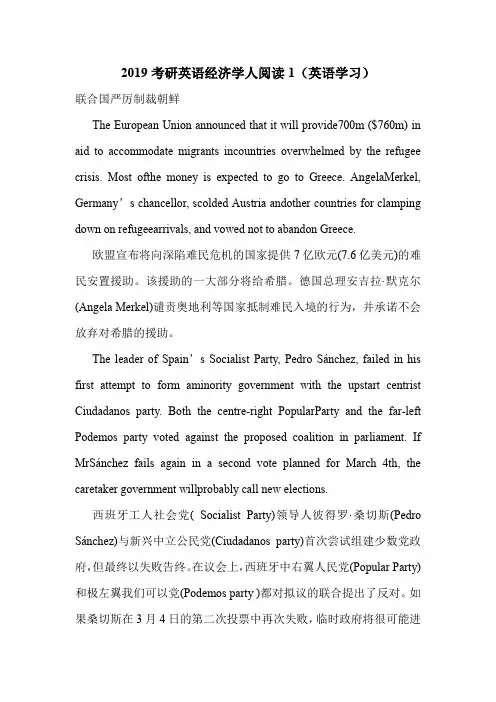
2019考研英语经济学人阅读1(英语学习)联合国严厉制裁朝鲜The European Union announced that it will provide700m ($760m) in aid to accommodate migrants incountries overwhelmed by the refugee crisis. Most ofthe money is expected to go to Greece. AngelaMerkel, Germany’s chancellor, scolded Austria andother countries for clamping down on refugeearrivals, and vowed not to abandon Greece.欧盟宣布将向深陷难民危机的国家提供7亿欧元(7.6亿美元)的难民安置援助。
该援助的一大部分将给希腊。
德国总理安吉拉·默克尔(Angela Merkel)谴责奥地利等国家抵制难民入境的行为,并承诺不会放弃对希腊的援助。
The leader of Spain’s Socialist Party, Pedro Sánchez, failed in his first attempt to form aminority government with the upstart centrist Ciudadanos party. Both the centre-right PopularParty and the far-left Podemos party voted against the proposed coalition in parliament. If MrSánchez fails again in a second vote planned for March 4th, the caretaker government willprobably call new elections.西班牙工人社会党( Socialist Party)领导人彼得罗·桑切斯(Pedro Sánchez)与新兴中立公民党(Ciudadanos party)首次尝试组建少数党政府,但最终以失败告终。
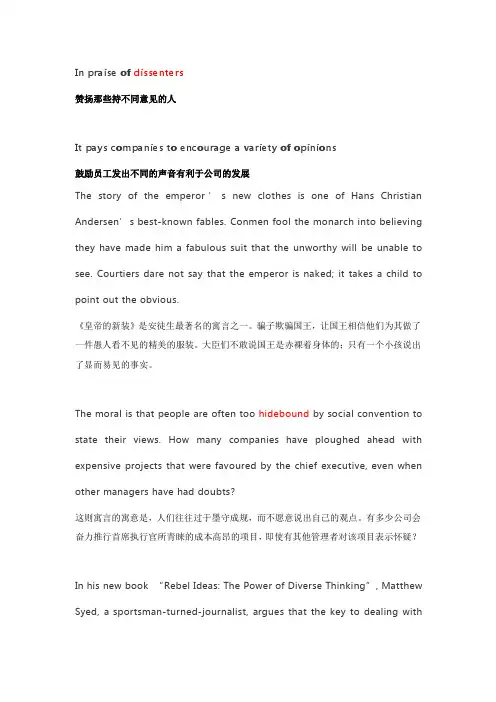
In praise of dissenters赞扬那些持不同意见的人It pays companies to encourage a variety of opinions鼓励员工发出不同的声音有利于公司的发展The story of the emperor’s new clothes is one of Hans Christian Andersen’s best-known fables.Conmen fool the monarch into believing they have made him a fabulous suit that the unworthy will be unable to see.Courtiers dare not say that the emperor is naked;it takes a child to point out the obvious.《皇帝的新装》是安徒生最著名的寓言之一。
骗子欺骗国王,让国王相信他们为其做了一件愚人看不见的精美的服装。
大臣们不敢说国王是赤裸着身体的;只有一个小孩说出了显而易见的事实。
The moral is that people are often too hidebound by social convention to state their views.How many companies have ploughed ahead with expensive projects that were favoured by the chief executive,even when other managers have had doubts?这则寓言的寓意是,人们往往过于墨守成规,而不愿意说出自己的观点。
有多少公司会奋力推行首席执行官所青睐的成本高昂的项目,即使有其他管理者对该项目表示怀疑?In his new book“Rebel Ideas:The Power of Diverse Thinking”,Matthew Syed,a sportsman-turned-journalist,argues that the key to dealing withthis problem is“cognitive diversity”.In other words,assembling a team of people with different perspectives and intellectual backgrounds.运动员出身的记者马修·施雅德在其新书《反叛思想:多元化思维的力量》中认为,解决这一问题的关键在于“认知多样性”。
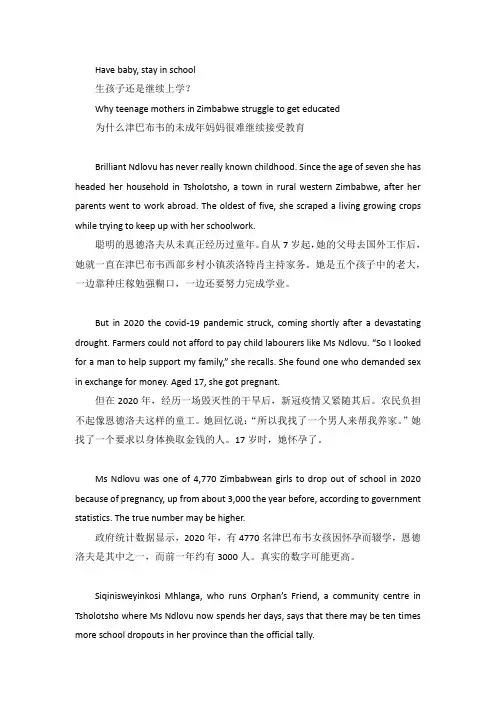
Have baby, stay in school生孩子还是继续上学?Why teenage mothers in Zimbabwe struggle to get educated为什么津巴布韦的未成年妈妈很难继续接受教育Brilliant Ndlovu has never really known childhood. Since the age of seven she has headed her household in Tsholotsho, a town in rural western Zimbabwe, after her parents went to work abroad. The oldest of five, she scraped a living growing crops while trying to keep up with her schoolwork.聪明的恩德洛夫从未真正经历过童年。
自从7岁起,她的父母去国外工作后,她就一直在津巴布韦西部乡村小镇茨洛特肖主持家务。
她是五个孩子中的老大,一边靠种庄稼勉强糊口,一边还要努力完成学业。
But in 2020 the covid-19 pandemic struck, coming shortly after a devastating drought. Farmers could not afford to pay child labourers like Ms Ndlovu. “So I looked for a man to help support my family,” she recalls. She found one who demanded sex in exchange for money. Aged 17, she got pregnant.但在2020年,经历一场毁灭性的干旱后,新冠疫情又紧随其后。
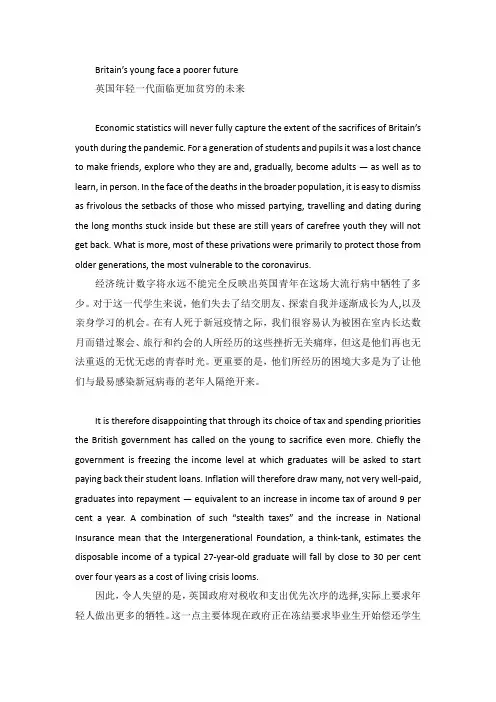
Britain’s young face a poorer future英国年轻一代面临更加贫穷的未来Economic statistics will never fully capture the extent of the sacrifices of Britain’s youth during the pandemic. For a generation of students and pupils it was a lost chance to make friends, explore who they are and, gradually, become adults — as well as to learn, in person. In the face of the deaths in the broader population, it is easy to dismiss as frivolous the setbacks of those who missed partying, travelling and dating during the long months stuck inside but these are still years of carefree youth they will not get back. What is more, most of these privations were primarily to protect those from older generations, the most vulnerable to the coronavirus.经济统计数字将永远不能完全反映出英国青年在这场大流行病中牺牲了多少。
对于这一代学生来说,他们失去了结交朋友、探索自我并逐渐成长为人,以及亲身学习的机会。
在有人死于新冠疫情之际,我们很容易认为被困在室内长达数月而错过聚会、旅行和约会的人所经历的这些挫折无关痛痒,但这是他们再也无法重返的无忧无虑的青春时光。
The Guardian view on secondhand clothes: the thrill of the old《卫报》关于二手衣服的观点:旧衣服的激动“Few articles change owners more frequently than clothes. They travel downwards from grade to grade in the social scale with remarkable regularity,” wrote the journalist Adolphe Smith in 1877 as he traced a garment’s journey: cleaned, repaired and resold repeatedly; eventually cut down into a smaller item; finally, when it was beyond all wearability, the fibres recycled into new fabric for the wealthier classes.记者史密斯在1877年追踪一件衣服的历程时写道:“很少有物品能比衣服更频繁地更换主人了。
它们在社会阶层中逐级向下移动,具有显著的规律性”:反复清洗、修补和转售;最终被切割成更小的部分;最后,当它已经不适合穿着的时候,这些纤维就被回收制成新的布料,供富裕阶层使用。
That model is almost incomprehensible in the era of fast fashion. The average British customer buys four items a month, often at pocket-money prices; though the low cost is a godsend for the hard-up, many purchases are discarded after a few outings, or never worn at all. Clothes Aid reports that 350,000 tonnes of used but still wearable clothing goes to landfill in the UK each year.在快时尚的时代,这种模式几乎是不可理解的。
关于经济类英语文章阅读范文欣赏经济方面的问题一直都是为人们所重点关注的,作为写作话题也是很常见的。
今天小编在这里为大家介绍关于经济类英语文章阅读,欢迎大家阅读!关于经济类英语文章篇1 东南亚诸国无惧英国脱欧唯怕中国经济放缓or Southeast Asia, the slowdown of Chinas economy may have a bigger economic impactthan the British vote to leave the European Union.对东南亚地区来说,中国经济放缓对其经济的影响可能要比英国公投脱欧大得多。
Chinas government reported the countrys economy expanded at 6.7 percent in the first threemonths of this year. That is high compared to many countries. However, it is the lowestincrease of its Gross Domestic Product, or GDP, since early 2009.根据政府报告显示,我国今年前三个月的经济增速为6.7%。
这个增速已经比很多国家要高了。
但是,这是自2009年年初以来国内生产总值(GDP)最低的一次增长。
Joseph Incalcaterra is an economist with the British bankHSBC. He has studied economicgrowth in Asia from 2000 to 2014. He says Chinese trade became more and more important inthe area during those years. Yet, he notes that Chinas slowing economy is, in his words, weighing down exports in the rest of the region.尹正和是在英国汇丰银行工作的经济学家。
Uncovering Peru’s neglected splendours揭开秘鲁被忽视的辉煌O ne night in1987the police woke Walter Alva,a Peruvian archaeologist, and invited him to come to inspect some stolen gold objects.1987年的一天夜里,警察叫醒了秘鲁考古学家沃尔特·阿尔瓦,并请他去检查一些被盗的金器。
The tip would lead Mr Alva to discover the intact tomb of a ruler of the Mochica(or Moche)civilisation,whom he dubbed the Lord of Sipán.这条线索将引领着阿尔瓦发现一个保存完好的莫奇卡文明统治者的墓穴,他将其称为西潘王。
It held the lord’s full regalia of gold breastplates and crowns,exquisite nose-and ear-pieces and a unique necklace of giant gold and silver peanuts.这位统治者身上穿戴着象征王侯贵族的全套装饰,他胸披金甲、头戴金冠,鼻饰和耳饰尤为精致,脖子上还戴着一条独特的巨型金银花生项链。
It was the start of an archaeological revolution in northern Peru.Since then Mochica temples,built from mud reinforced with gravel and shells,have been unearthed at Huaca de la Luna,near the colonial city of Trujillo.秘鲁北部的考古革命从这里开始。
第1段:英国对其高管推行新规定,鼓励“长期效益主义”;第2段~4段:短期效益主义;(短期效益占主流、短期效益主义的弊端、美国短期效益占主导地位)第5~6段:列举美法推行“长期效益主义”的措施;第7段:英国新规定提醒银行高管重视“长期效益”;(【兔子考研】微信公众号)1,one motive in imposing is the_________.22.Alfred Marshall is quoted to23.It is argued that the influence be__________.24.The US and France examples are used to illustrate____________.25.Which of the following would be the best title for the text?由楼上题干分析可知,此篇文章围绕长期效益和短期效益展开论述。
❶Financial regulations in Britain have imposed a rather unusual rule on the bosses of big banks.❷Starting next year,any guaranteed bonus of top executives could be delayed10years if their banks are under investigation for wrongdoing.❸The main purpose of this“clawback”rule is to hold bankers accountable for harmful risk-taking and to restore public trust in financial institution.❹Yet officials also hope for a much larger benefit:more long term decision-making not only byeconomy for future generations.have(强调新规其不同寻常)on the bosses of big banks.❷Starting next(高管的保证金)of top if their banks areunder investigation for❸主要目的和次要目的)of this“clawback”rule is to hold bankers accountable for harmfulrisk-taking and to restore.(转折之后为重点,重点往往是考点)officials also hope for a much larger点)more long term decision-making not only by banks but by all corporations,to build a stronger economy for future generations.(【兔子考研】微信公众号)翻译:❶英国的金融法规对大银行的老板实施了一项不寻常的规定。
How spider silk avoids hungry bacteria蜘蛛丝是如何免于被饥肠辘辘的细菌蚕食的No antibiotics are involved它们并非以抗生素抗菌Tougher than any fibre made by humans and extraordinarily good at transmitting vibrations to the predators that weave it,spider silk has been a source of inspiration for the development of everything from scaffolding for regenerating bones to bulletproof vests,remote sensors and noise reducers.蜘蛛丝比任何人类制造的纤维都要坚韧,而且它还特别利于将震动传递给编织出它的捕食者。
从用于骨骼再生的支架到防弹背心,再从远程传感器到降噪器,蜘蛛丝一直是人类各种发明的灵感源泉。
Yet one of its most remarkable attributes,its resistance to decay,has received little attention.Some researchers speculate that spider silk keeps hungry bacteria at bay by being laced with antibiotics.然而,作为其最显著特性之一的抗腐坏性却很少受到人们的关注。
一些研究人员推测,蜘蛛丝是因为添加了抗生素才得以远离饥肠辘辘的细菌的。
But work by Wang Pi-Han and Tso I-Min at Tunghai University,in Taiwan, published in the Journal of Experimental Biology,suggests this is not thecase.Rather,silk manages to avoid being eaten by locking the nutrients it contains behind an impenetrable barrier.但据台湾东海大学的王必汉和曹一鸣发表在《实验生物学杂志》上的研究表明,事实并非如此。
Prices of prime properties around the world are falling世界各地的豪宅都在跌One Blackfriars soars into the sky from the south bank of the River Thames, announcing its presence to central London.The new50-storey tower contains274luxury flats that range in value from a merely expensive£1m ($1.3m)to an eye-watering£15m.坐落在泰晤士河南岸的布莱克法尔一号直插云霄,仿佛在向伦敦市中心宣示着它的存在。
这座新建的50层高的大楼共有274套豪华公寓,公寓的售价从不算太贵的100万英镑(约合130万美元)到令人瞠目结舌的1500万英镑不等。
Thanks to its distinctive midriff the building has been nicknamed“The Tummy”by Robert Shiller,who won a Nobel economics prize for his work on spotting asset bubbles.The name might also apply to London’s bloated housing market.Prices have nearly doubled since2009.由于其独特的类似于人体腹部的造型,这座建筑被罗伯特·希勒戏称为“大肚子”,希勒曾因发现了资产泡沫而荣获诺贝尔经济学奖。
这个昵称或许一语双关,还指代了伦敦膨胀的住宅市场。
自2009年以来,伦敦的房价几乎翻了一番。
It is not only in London that property values bulged in the decade after a housing bust that nearly took down the world’s financial system:prices are near new highs in manyplaces,according to The Economist’s latest roundup of global housing markets.根据《经济学人》对全球住宅市场的最新概览,在几乎摧毁了世界金融体系的房地产泡沫破灭后的十年时间里,不仅伦敦的房价大幅上涨,许多地方的房价都创下新高。
还算公道——中美洲咖啡与“啡农” Fair enough(还算公道)
MAKING good coffee is not a simple business. Coffee bushes must be grown in shade—neither too much, nor too little. A hillside is best—but it mustn't be too s______①. After three years, the bushes will start to produce bright-red coffee “cherries”, which are picked, processed to remove the pulp, and spread out to dry for days, ideally on concrete. They are m_______② again to separate the bean, which needs to rest, preferably for a few months. (1)Only then can it be roasted, ground and brewed into the stuff that dreams are ★quelled with[1].
In Mexico and parts of Central America, as in Colombia and Peru further south but not in Brazil, most coffee farmers are smallholders. (2)They found it especially hard to deal with the recent ★slump[2] in the coffee price. The price has since recovered: the benchmark price applied to m________③ coffee now ranges from $1.11 to $1.14 per pound. That is roughly double its ★rock-bottom[3] level of August 2002.
But the v_________④ of their income makes it hard for farmers to invest to sustain their crop, says Fernando Celis of the Mexican National Organisation of Coffee Growers. The slump forced many small farmers to switch to other crops, or migrate to cities. Mexico's exports of coffee are less than half of what they were six years ago.
(3)For farmers, one way out of this dilemma is to decouple the price they are paid from the international commodities markets. This is the a_______⑤ of Fairtrade, a London-based organisation which certifies products as “responsibly” sourced. Fairtrade determines at what price farmers make what it considers a reasonable profit. Its current calculation is that the appropriate figure is 10% above the market price. W________⑥, sales of Fairtrade-certified coffee have increased from $22.5m per year to $87m per year since 1998. This is still only a tiny fraction of the overall world coffee trade, worth $10 billion annually. But there are plenty of other ★niche markets[4] for high-quality coffee. Some small producers can c_________⑦ more by marketing their coffee as organic—a switch which takes five years or so—or “bird-friendly” (4)because, unlike large, mechanised plantations, they have retained shade trees.
Starbucks, the Seattle-based coffee-bar c________⑧, says it uses a similar formula to that of Fairtrade in buying its coffee. All is bought at a “fair price”, says Peter Torrebiarte, who manages Starbucks' buying operation in Costa Rica.
(5)Some niches can be large. Only 6% of world o________⑨ is of top quality, but in Costa Rica and Guatemala the figure rises to 60%, says Mr Torrebiarte. Starbucks bought 37% of Costa Rica's entire coffee crop in the 2004-05 season, according to Adolfo Lizano of the country's coffee institute.
Mexico lags behind its neighbours in extracting higher prices. But 95% of the coffee in Mexico is arabica—the type of bean demanded by connoisseurs—rather than lower-grade robusta. Almost all of it is grown at a________⑩, which also improves quality. So Mexico, too, has the potential to compete on quality rather than price. Only by following the path forged by Costa Rica and Guatemala, says Mr Celis, can Mexico's coffee growers survive in the world market. (6)For their part, discerning coffee drinkers can satisfy their palate and their conscience at the same time.
[QUIZ] (下列2题任选其一即可,认真答题者即给予80沪元奖励。不答题仅提问者,亦可得到至少20沪元奖励) 1. 根据空白后括号里面的词性提示和英文释义以及首字母,填入合适的单词(注意单词形式变化)。 ①s______(adj. rising or falling at a sharp angle) ②m______(v. to crush grain, pepper, etc into flour) ③m_______(adj. not very strong or hot-tasting) ④v_________(n. likelihood to change suddenly and unexpectedly or suddenly become violent or angry) ⑤a_______(n. something you hope to achieve by doing something) ⑥W________(adj. everywhere in the world) ⑦c_________ (v. to ask someone for a particular amount of money for something you are selling) ⑧c________(n. a number of shops, hotels, cinemas etc owned or managed by the same company or person) ⑨o________(n. the amount of goods or work produced by a person, machine, factory etc;production) ⑩a________(n. the height of an object or place above the sea) 2. 将文中划线部分英语翻译成汉语:
[NOTES](LONGMAN) [1] quell [transitive] formal 1to end a situation in which people are behaving violently or protesting, especially by using force [= put down] 镇压 quell the violence/disturbance/riot etc Police used live ammunition to quell the disturbances. 2 literary to reduce or stop unpleasant feelings such as fear, doubt, or worry: 压制,压抑,平息 'Jerry?' she called, trying to quell the panic inside her.